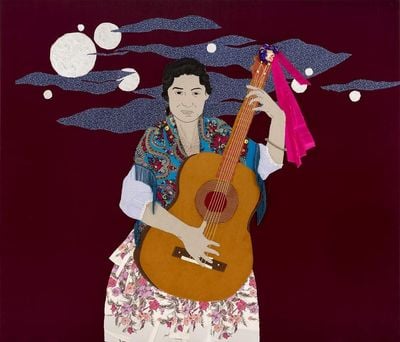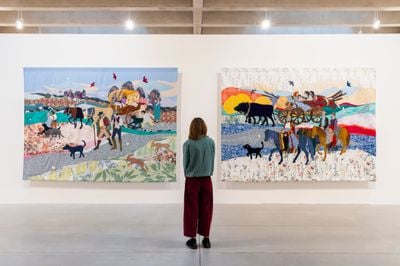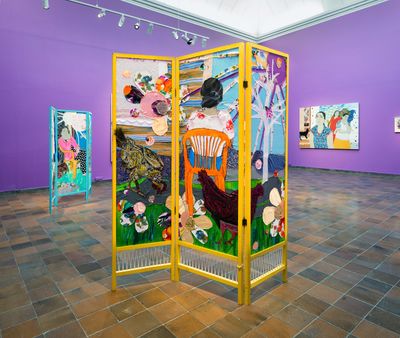
31 Oct Unmissable: Małgorzata Mirga-Tas Recasts Romani Stories with Love
Source Credit: Content and images from Ocula Magazine. Read the original article - https://ocula.com/magazine/insights/malgorzata-mirga-tas-tate-st-ives/
By cutting, arranging, and stitching second-hand fabrics into painterly compositions worked over with acrylics, Małgorzata Mirga-Tas recasts Romani stories and lives beyond the violence of historic stereotypes.

Małgorzata Mirga-Tas, Untitled (After Gentile da Fabriano) (2023). Exhibition view: Małgorzata Mirga-Tas, Tate St Ives (19 October 2024–5 January 2025). © Małgorzata Mirga-Tas. Photo © Tate (Lucy Green).
In 2022, Mirga-Tas became the first Roma artist to represent a national pavilion at the Venice Biennale, with her striking installation of 12 large-format textile compositions, based on the months of the year, presented in the Polish Pavilion.
One of those panels, which drew from the astrological frescos of the Palazzo Schifanoia in Ferrara, has been included in her first major institutional show in the U.K. at Tate St. Ives, curated by Anne Barlow.
Małgorzata Mirga-Tas, Romani Kali Daj (Roma Madonna) (2024); June (2022) and Ćhajengri Duma (Women’s Thoughts) (2024). Exhibition view: Małgorzata Mirga-Tas, Tate St Ives (19 October 2024–5 January 2025). © Małgorzata Mirga-Tas. Photo © Tate (Lucy Green).
Divided into three tiers, June (2022) is a large, wall-length compositions that shows archival scenes of Roma people drawn from etchings by 17th-century French printmaker Jacques Callot; representations of important Romani figures, including singer and composer Esma Redžepova and musician Krystyna Perta Markowska; and a depiction of Romani women sewing and hanging laundry together—including the artist and her young son.
Flanking the panel are two monumental commissions that recuperate representations of Roma women in the 19th century. Romani Kali Daj (Roma Madonna, 2024), recreates French artist William-Adolphe Bouguereau 1879 painting Young Gypsies, whose title reflects the consistent reduction of Romani people to a derogatory and inaccurate term. (The word ‘gypsy’ derived from the misconception that the Roma people hailed from Egypt, rather than Northern India.) While Chajengri Duma (Women’s Thoughts, 2024) shows two Andalusian Romani women originally captured in a 19th-century archival photograph.
Małgorzata Mirga-Tas, Juana Vargas de las Heras ‘La Macarrona’ (2023). Courtesy the artist and Frith Street Gallery, London, Foksal Gallery Foundation, Warsaw and Karma International, Zurich. Photo José Morón.
‘I wanted to show Romani women who have never been identified by name, but only used as an interesting exotic image,’ Mirga-Tas explains in the wall text. ‘Delving into their history—or rather the lack of history—I decided to pay homage and respect to them.’
Nearby, works from the series ‘The Sacristy of Gitanas Flamencas’ (2023), originally produced for the Centro Andaluz de Arte Contemporáneo in Seville, celebrates the contribution of Romani culture to flamenco music and dance in Spain. Portraits of famous Andalusian Romani women rendered in fabric on shimmering burgundy grounds include renowned flamenco performer Juana Vargas de las Heras ‘La Macarrona’ (2023), based on a late-19th-century photograph.
Małgorzata Mirga-Tas, Dromeskri Zuta (On the Journey) (2024); Still on the Journey (2024). Exhibition view: Małgorzata Mirga-Tas, Tate St Ives (19 October 2024–5 January 2025). © Małgorzata Mirga-Tas. Photo © Tate (Lucy Green).
The love with which Mirga-Tas treats her subjects is palpable. Large-scale works like On the Journey (2024) and Still on the Journey (2024) reference a 19th-century etching by Auguste Raffet but reclaim the French artist’s historically stereotypical representation of Romani.
The intention, Mirga-Tas explained during a tour of the show, is to highlight the will to live embodied by the moving caravan: historically, the Romani were forced to adopt an itinerant existence because of the intense persecution they faced. The artist amplifies that lived experience by restoring colour, texture, and life to those who have historically been stripped of it.
Małgorzata Mirga-Tas, My Mother (2019). © Małgorzata Mirga-Tas. Courtesy Tate. Purchased with funds provided by the Russia and Eastern Europe Acquisitions Committee 2021. Exhibition view: I Have a Dream, Goteborgs Konsthall (2023). Photo: Hendrik Zeitler.
Family members feature prominently in the artist’s practice, including in three pieces whose acquisition marked the first time works by an artist of Romani heritage entered the Tate collection.
Among them is My Mother (2019), a three-panel, two-sided portrait of the artist’s mother presented on a bright-yellow freestanding screen, which comes from the series ‘Roma Madonna’ (2016–2020), depicting Roma women in the artist’s native Poland. Another is The Three Graces (2021), based on a photograph taken in the 1980s by the artist’s uncle, Andrzej Mirga, who was the only Roma ethnographer in Poland at that time.
Małgorzata Mirga-Tas, Krystyna Gil, from the series ‘Siukar Manusia’ (2022). Exhibition view: Małgorzata Mirga-Tas, Tate St Ives (19 October 2024–5 January 2025). © Małgorzata Mirga-Tas. Photo © Tate (Lucy Green).
A powerful and moving body of work concludes the artist’s Tate exhibition. The final room contains six portraits from the series ‘Siukar Manusia’ (Great People, 2022), which the artist developed by working with various archives, as well as with her subjects’ families, to select the best images and textiles to honour their likeness.
Presented on a dark blue fabric backdrop, each image depicts a first-generation Romani inhabitant of the Nowa Huta district in eastern Krakow, most of whom are survivors or descendants of the Romani holocaust, known as the Porrajmos (Devouring). Among those represented is Wanda Siwak, who was imprisoned by the Nazis in a concentration camp during World War II, when some 500,000 Roma and Sinti people died.
Małgorzata Mirga-Tas, The Three Graces (2021); Romni (2023), and Side Thawenca (Sewn with Threads) (2019). Exhibition view: Małgorzata Mirga-Tas, Tate St Ives (19 October 2024–5 January 2025). © Małgorzata Mirga-Tas. Photo © Tate (Lucy Green).
Siwak, we learn, hid her daughter from the Nazis before she was imprisoned, then spent the rest of her life trying to find her after the war. She eventually passed on the task to her nephew, Edward Dunka, who succeeded in tracing her family in present-day Ukraine.
Dunka, an activist who has campaigned for Romani rights in Poland, is portrayed in another image nearby, facing his aunt—a moving expression of continuity in a struggle in which Mirga-Tas also plays her part. —[O]
Source Credit: Content and images from Ocula Magazine. Read the original article - https://ocula.com/magazine/insights/malgorzata-mirga-tas-tate-st-ives/








